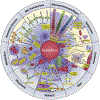Cancer stem cells and strategies for targeted drug delivery
- PMID: 33095384
- PMCID: PMC8062588
- DOI: 10.1007/s13346-020-00863-9
Cancer stem cells and strategies for targeted drug delivery
Abstract
Cancer stem cells (CSCs) are a small proportion of cancer cells with high tumorigenic activity, self-renewal ability, and multilineage differentiation potential. Standard anti-tumor therapies including conventional chemotherapy, radiation therapy, and molecularly targeted therapies are not effective against CSCs, and often lead to enrichment of CSCs that can result in tumor relapse. Therefore, it is hypothesized that targeting CSCs is key to increasing the efficacy of cancer therapies. In this review, CSC properties including CSC markers, their role in tumor growth, invasiveness, metastasis, and drug resistance, as well as CSC microenvironment are discussed. Further, CSC-targeted strategies including the use of targeted drug delivery systems are examined.
Keywords: Anti-tumor therapy; Cancer biology; Cancer stem cells (CSCs); Drug delivery system; Drug-resistance.
© 2020. Controlled Release Society.
Conflict of interest statement
Figures





References
-
- Chapter 12 - Cancer Stem Cells: Where Do They Come From and Where Are They Going? In: Mummery C, van de Stolpe A, Roelen BAJ, Clevers H, editors. Stem Cells (Second Edition). Boston: Academic Press; 2014. p. 315–41.
-
- Bonnet D, Dick JE. Human acute myeloid leukemia is organized as a hierarchy that originates from a primitive hematopoietic cell. Nat Med. 1997;3(7):730–7. - PubMed
Publication types
MeSH terms
Substances
Grants and funding
LinkOut - more resources
Full Text Sources
Medical

